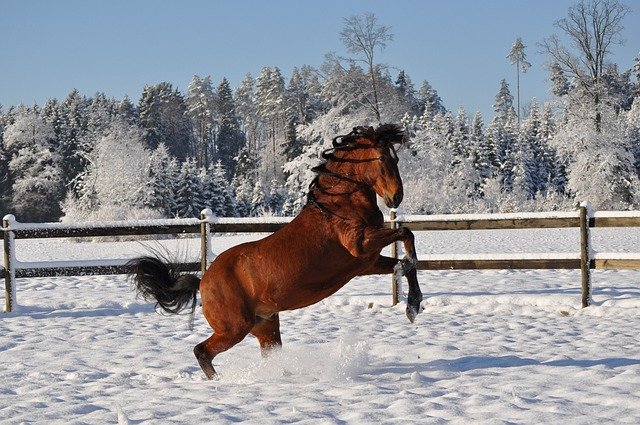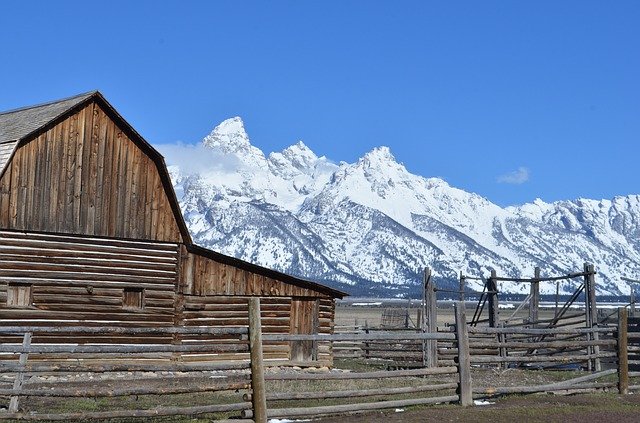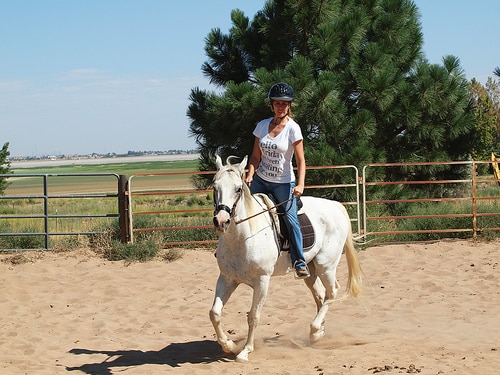
With winter in full swing, many of us in the northern hemisphere are dealing with plummeting temperatures and the ever-present threat of snow. Those of us not lucky enough to have access to indoor arenas have to find ways to keep our horses fit despite the snow and ice. Here are 4 methods I have found to maintain your horse’s winter fitness.
(Click here if you are looking for tips on rider fitness.)
4 Methods to Maintain Winter Fitness
1. Riding at the walk
Riding is still your best bet to keep your horse in shape. However it should only be done if conditions allow. A hot horse with a tendency to act up or bolt should never be ridden in snowy conditions. Young horses who are still too unseasoned to be predictable also should not be ridden in the snow in case they try to pull some stupid stunt as the young ones are prone to do.
2. Hand walking
For the young, unpredictable, and/or hot horses who can’t be ridden in snowy conditions, hand walking is a good option. This one may seem simple and pointless, but you would be surprised how beneficially simple walking is to your horse’s fitness.
If your horse is still in decent shape, saddle up your horse so he’s carrying some weight, even if he isn’t carrying a rider. For a horse that hasn’t been out of work long enough to lose muscle tone, I might even go so far as to put saddlebags on him — although this should only be done if he is already used to saddle bags. Put a couple of water bottles in the saddle bags to add some weight. It is very important though that the saddlebags are balanced with equal weight on both sides and fastened securely so they don’t shift. I like to use a rope halter as it is more secure and gives you a little more control in case things go south.
3. Lunging at the walk
This should be done with the utmost caution. Too many horses have been conditioned to view lunging as a way to blow off steam. This may cause them to become hot on the lunge line and attempt to trot or canter. This can be extremely dangerous if the ground is slick with slush and ice. Only attempt this if your horse already knows how to lunge properly at the walk.
4. Turnout in a paddock
This is best when used in conjunction with one or more of the other exercises as turnout alone will not be enough to keep your horse fit, but it will help slow the loss of muscle tone. A large paddock is a good option if it is not too icy. However, this should only be used for horses that are used to being turned out in less than ideal conditions. Horses that have been turned out in rain and mud should be ok. But if your horse gets brought in from the field every time the forecast calls for a thunderstorm, it should go without saying that this is probably not the best option for him.
Horses turned out in a paddock should be supervised and not left out for more than 2 or 3 hours — enough time for them to get the kinks out and get some exercise, but not enough time for most horses to get bored enough to start looking for ways to maim themselves. Horses also should only be turned out with their regular pasture mates as they will already have something of an established pecking order. This is not the time or place for meeting new friends and sorting out a whole new pecking order.
Tips for Winter Fitness Success
1. Don’t let your horse be a slacker
Just because you can’t ride — or lunge — faster than a walk doesn’t mean your horse gets to slack. He should still be picking up that back and working that hind end. That is the only way he will stay in shape. If you want to stay in shape by walking every day, which is going to be more beneficial; slouching along at a snail’s pace or walking briskly with good posture and energy? I certainly hope your answer was the latter. Why would it be any different for your horse? If you are going to let him slouch along slower than a lame sloth, you are freezing your butt off for nothing.
2. Make sure you get the hind end working properly
The biggest concern you should have is making sure that hind end is working properly. Make sure he is tracking up under himself with the back hoof landing in or near the hoofprint of the front hoof. This is even easier to do in the snow as the hoofprints show up better so you can better tell how much they are overlapping.
3. Keep up on your hoof care
I hear some people say that they don’t get the farrier out often over winter because the horse isn’t working. Just because the horse isn’t working near as much doesn’t mean his feet have magically stopped growing. That’s not to say that the growth rate doesn’t change at all. My horses that are out on pasture all summer often need their feet done every 4 weeks. But once they are off pasture for the winter we can push it to every 6 weeks. Slacking on hoof care over winter only creates more problems in the long run and often creates the very chronic problems these same people complain about during the summer.
4. Adjust your feed regimen to match your horse’s activity level
You feed according to your horse’s activity level. If your horse’s workload has decreased significantly over winter, you should decrease his feed accordingly. Be careful to do it gradually though. Sudden changes in feed can cause colic and digestive upset in some horses.
Methods Not to Use for Winter Fitness
You may come across recommendations of alternative methods that may seem easier, but easier is not always better. Here are a few methods I do not recommend due to safety concerns.
1. Round penning
Round penning is a common method, especially among the natural horsemanship crowd. The biggest problem with round penning is that it is often rushed and chaotic. There is no lungeline and, therefore, no physical connection to the horse to keep control of the situation and prevent injury. Exercise in wet, snowy, icy conditions needs to be slow and deliberate. Round penning, if it done at all, should only be done on dry ground under ideal conditions to prevent slips and falls during sudden changes of direction.
2. Hot walker
Some may argue that a hot walker is just like lunging. In a sense this may be true. But a hot walker involves hooker the horse to a metal arm above their head. The lead must be short enough that they cannot get a leg over it while unattended, which means that they cannot get the head down too far for safety reasons. This restricts their head movement, preventing them from really stretching down and working their topline properly. Add in the mechanized element where the horse is left to their own devices without human supervision to ensure that they are exercising properly and getting the most out of their workout and suddenly you have and exercise in futility.
3. Turnout in a pasture for winter fitness
Turnout during winter months is good to allow your horse to stretch his legs and refresh his mind. However, horses should only be turned out in paddocks. Paddocks should be large enough for them to run a bit, but small enough so they cannot build up enough speed to be a danger to themselves. Turning your horse out in their regular pasture will also ruin the grass as they churn up the mud. So your should set aside a “sacrifice area” that you don’t mind being ruined.









